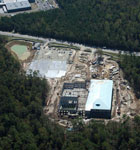David Giambrone, a third-generation bricklayer from Ohio, had an intense desire for independence that drove him to launch Giambrone Masonry, Inc. (GMI), a firm that specializes in masonry and stone installation. The venture was successful enough that, along with his wife, Pat, David has expanded operations to include Giambrone Construction, Inc. (GCI), a full service general-contracting firm; Universal Scaffolding; Certified Supply; and Spray Foam Technologies of Ohio. Together, the companies have earned the clout to win work on Cleveland sporting venues, including Progressive Field, the Wolstein Center, and Cleveland Browns Stadium. With its headquarters in Hudson, Ohio, Giambrone Companies attributes its success (GMI’s annual sales growth over the past four years has been 26 percent) to its trained staff and its commitment to excellence. Here, David details how his combined companies work together on larger projects.
1977
GMI begins with David Giambrone and his motorcycle, which is his “work truck.” He sells his beloved motorcycle for the company’s first forklift, a Skytrack, which is still operational today. David and his first employee—his father, Frank Giambrone—perform small masonry projects, consistently building the company. According to David, they focus on quality craftsmanship and integrity, business practices in short supply in Cleveland’s 1970s construction market.
1980s
David meets his wife, Patricia (who goes by Pat), while leasing a vehicle from the dealership where she is employed. Pat soon joins David and manages the company’s accounting and office operations. Around this time, GMI performs multiple projects for Panzica Construction Company, David’s cousins’ commercial construction company. As GMI’s reputation grows, so does the profile of David’s project list.
1991
GMI’s first landmark project opens, the $55 million state-of-the-art, full-service, multipurpose Cleveland State Convocation Center (now known as the Wolestein Center). In addition to accommodating Cleveland State University’s sports teams, the 315,000-square-foot venue has since hosted numerous rock, pop, and country music shows—and traveling performances of American Idol, High School Musical, Barney, The Wiggles, and Cirque du Soleil.
1994
GMI completes work on Jacob’s Field (now known as Progressive Field), the 43,400-capacity home of the Cleveland Indians baseball team. As a subcontractor for the Albert M. Higley Company, the firm helps build the arena’s concession stands.
Mid-1990s
With the formation of the Ohio School Facilities Commission (OSFC)—which helps school districts fund, plan, design, and build or renovate schools—educational construction takes off. The spike prompts formation of Giambrone Construction, with Pat and David serving respectively as president and vice president. From 1999–2012, Giambrone Construction completes more than $80 million in OSFC contracts.
1997
GMI assists with construction of Canal Park—a baseball stadium in Akron, Ohio, where the AA Akron Aeros play—and Cleveland Browns Stadium. David witnesses 2,200 workers tackling the latter project while his firm completes the facility’s masonry.
2002
After 25 years of steady growth, Giambrone Companies begins construction of its current corporate headquarters in Hudson, Ohio. David opts to never display a company sign on the impressive structure, saying, “I don’t find it necessary.” He remains intimately involved in day-to-day office functions and still opens all the company mail, insisting that it “keeps [him] in the loop.” Giambrone Companies also restores the Akron Civic Theatre this year.
2011
GCI and GMI begin construction of the new Maple Heights High School, David’s alma mater. A year later, 40 years after graduating, David watches as construction of the new high school is completed.
What made you create these particular businesses under the Giambrone Co. umbrella?
The long and the short of it is that it was a matter a synergy, as all of the companies are interrelated. They were also created to provide opportunity to Giambrone’s employees, supply a greater service to our clients, and make us more competitive and consistent by [allowing us to self-perform] more work with our established in-house workforce.

You’ve worked on a number of Cleveland-area sports facilities, including Progressive Field, the Wolstein Center, and Cleveland Browns Stadium. What makes Giambrone Companies such a good fit for this type of project?
These projects were large, high-profile union projects. As a third-generation bricklayer, I’m a firm believer and active participant in all things union. It’s that intimate knowl-edge of how the local unions operate that separates us from competitors. It may be cliché, but I’m not afraid of a challenge: instead of fear, I feel excitement. I’m thrilled that Giambrone gets to be involved in projects that the public will see and enjoy for decades—it means a lot to all of us.
Did you actively pursue high-profile projects? Any tips on how to win tenders for such work?
While we do pursue high-profile projects, it’s never been our business model to go after them exclusively. We treat each and every project with the same attention to detail as we would Cleveland Browns Stadium. GCI and GMI mostly target public work, which is considerably different from private work. In the private sector you build a relationship with the owner and/or architect. Whereas with public work the taxpayers’ dollars and/or the federal and/or state government fund the projects. Therefore, public bidding is extremely competitive, with bids awarded to the lowest and most responsible bidders. Your hard work and reputation go a long way. A reputation is easy to build but hard to maintain. The best tip I can give—and one I’ve lived by my whole life—is live within your means. Case in point, our companies don’t have lines of credit. We pay cash for everything and keep our bills paid.

Can you detail with an example how the various elements of Giambrone Co. work together on a larger-scale project?
Maple Heights High School [MHHS]. We worked together from the absolute beginning—from estimate to closeout. Doing so provided [the] owners a single point of contact for anything they needed. On bid day for MHHS, GMI supplied critical information that allowed GCI to reduce select costs before submitting the final bid, and [this] likely [made] the difference in winning the project. Unlike typical projects, where there is little collaboration and more directions, during early planning stages of the project at MHHS, it allowed the construction company to get their subcontractors under contract early to develop a real schedule [that becomes a working tool within the project]. It felt like a team effort from the beginning.

What sort of work have you done on stadiums? On Cleveland Browns Stadium, for example?
GMI was the masonry and stone contractor, 1 of 26 prime contractors. We provided all of the masonry and granite for the entire project. We were the only prime contractor to complete all its work on schedule … and, most importantly, we did not have any claims against us from any other prime contractors.
What’s unique about working on a stadium?
It has to be the sheer size and number of workers on one site. I remember during the Cleveland Browns Stadium project there were 2,200 construction workers on-site at one time. It’s not just design teams and contractors; it’s the entire community. It’s a privilege and an honor to be a part of a project that normally only happens once in a lifetime.
What are your plans for the future?
First and foremost, continue to live within our means. Then it’s just a matter of taking it day by day, continuing to look for new opportunities and areas of improvement. The simple goal is to be better tomorrow than we are today. ABQ


